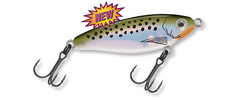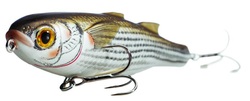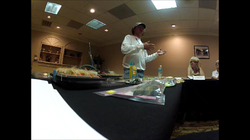Hard Lures

Capt. Kyle Messier with Florida Fishing Adventures was our guest speaker for the evening, educating us on the topic of live bait vs artificial lures. What we learned from Capt. Messier is that during a certain time of the year, specifically mid May all the way through the end of October, when the target fish are growing fat and sassy and pinfish begin to ravenously devour your live shrimp in a matter of seconds - is when it's time to either opt for bigger chunks of cut-bait, replace the shrimp with a soft plastic like Gulp or DOA, or try using a hard artificial lure or spoon. For new anglers, this can be a difficult transition, especially if you've grown accustomed to using live shrimp. Hard lures come with a few disadvantages, though. They're generally a bit awkward to cast at first, they can be a little costly, and they typically have six hooks to manage vs just one on a jig-head or circle hook. Another good reason to smash the barbs flat - this reduces the risk of injury to yourself or someone else close by. On the other hand, sometimes the size of the fish is a direct correlation to the size of the lure. Larger lures usually catch larger fish. That's not always true, but it's the general outcome.
Another tidbit of information to know:
A good temperature rule to follow:
Use shrimp if the waters are under 75 degrees / artificial baits/lures when over 75 degrees.
Every fish with a hook jaw looks up (trout, tarpon, ladyfish, etc.) and typically attack a top-water lure.
The MirrOlure brand makes a hard lure called the Mirrodine with its trademark "C-eyes" (or clear eyes). Kyle recommended investing in a few of these (any color is fine) as an alternative to Gulp - just for a change of pace. These are sub-surface lures that are designed to be worked about six inches below the water's surface. Top water feeders, like trout, (remember how they'll attack a floating popping cork) will see this and hopefully mistake it for an easy meal. The drawback to these lures is that if a fishes misses the hook but gets enough of it in his mouth to realize it's not the soft, natural texture he expected, chances are, he won't come back to it. This is why soft-plastics catch more fish than hard lures do.
Another tidbit of information to know:
A good temperature rule to follow:
Use shrimp if the waters are under 75 degrees / artificial baits/lures when over 75 degrees.
Every fish with a hook jaw looks up (trout, tarpon, ladyfish, etc.) and typically attack a top-water lure.
The MirrOlure brand makes a hard lure called the Mirrodine with its trademark "C-eyes" (or clear eyes). Kyle recommended investing in a few of these (any color is fine) as an alternative to Gulp - just for a change of pace. These are sub-surface lures that are designed to be worked about six inches below the water's surface. Top water feeders, like trout, (remember how they'll attack a floating popping cork) will see this and hopefully mistake it for an easy meal. The drawback to these lures is that if a fishes misses the hook but gets enough of it in his mouth to realize it's not the soft, natural texture he expected, chances are, he won't come back to it. This is why soft-plastics catch more fish than hard lures do.
Mullet Is The Key

If the Capt. said it once, he said it a hundred times; It's all about the mullet! If mullet are jumping, paddle there. If mullet are swimming, cast there. If you catch a mullet, cut it up and use it as bait. Want to catch more fish? Find the mullet and nothing imitates a mullet better than a real mullet, but this artificial mullet is the next best thing. This hard lure is called the "Live Mullet" by Live Target. DOA makes a similar mullet lure that Kyle uses during tarpon season in May and June and there are smaller versions that work just as well. Did we mention that mullet are a trout's favorite meal?
What About Spoons?

The cool part about spoons is that they force a fish into making an instant decision - whether or not to strike at that shiny thing that has grabbed their undivided attention, literally luring them to grab ahold. They must be retrieved with speed in order for them to be effective because they are designed to initiate a reaction strike but they don't work in every situation or environment and they are difficult to master from a kayak so you need to be selective when you use these. Stay with a 1/4 oz Weedless spoons, Johnson spoons, Aquadream spoons - they're all great Silver and gold are the traditional colors but new ones being manufactured with reflective designs add a little extra help to catch redfish, snook and trout. 1/2 oz Casting and Jigging spoons, similar to what's used up north, allow for a longer cast and are effective down here when targeting jacks, Spanish mackerel, bonita and bluefish from now until November, and they're fairly inexpensive.
Bait Scent

A quick discussion about bait scent. Capt. Messier is not a big fan of bait scent but admitted that every product had a time and place for use. If you have an unscented soft plastic bait but no Gulp brand bait on hand, then, by all means, use an artificial scent, just be aware that this product can be a little messy to use.
Bucktail Jigs

Hey Kyle - When do you use bucktail jigs?
"When you're fishing for Pompano"
"When you're fishing for Pompano"
Capt. Messier's Top 3
Rapala® Skitter Walk® - Top-water lure
MirrOlure Mirrodine - sub-surface lure
1/4 oz jig-head and Berkeley Gulp
(and, of course, live shrimp)
MirrOlure Mirrodine - sub-surface lure
1/4 oz jig-head and Berkeley Gulp
(and, of course, live shrimp)
It's Knot Time
So Where Do We Go?

The three most important signs to look for when searching for a good place to start fishing:
1. AREA: Learn how to identify a hard bottom. Kelp grass, which is long, brown and stringy, roots itself on hard bottom so start there if you happen to paddle up on some.
2. MOVING WATER: Rushing water through an oyster bar cut will carry bait fish that aren't strong enough to swim against that current. Guess who's waiting on the other side of that cut for a free meal to go by?
3. BAIT FISH: Look for mullet jumping. Look for bait fish jumping - something's after them...you might as well find out what it is.
He suggested the deeper pockets of water in and around Fish Creek and Pirate Cove. There's an area behind Mullet Key that holds a lot of kelp grass. At Pirate Cove you'll look for oyster bar. Water that 'shimmys' is usually a dead giveaway there's a shallow bottom, oyster bar, or a grass patch below it. And you'll want a lure that is designed for shallow water.
1. AREA: Learn how to identify a hard bottom. Kelp grass, which is long, brown and stringy, roots itself on hard bottom so start there if you happen to paddle up on some.
2. MOVING WATER: Rushing water through an oyster bar cut will carry bait fish that aren't strong enough to swim against that current. Guess who's waiting on the other side of that cut for a free meal to go by?
3. BAIT FISH: Look for mullet jumping. Look for bait fish jumping - something's after them...you might as well find out what it is.
He suggested the deeper pockets of water in and around Fish Creek and Pirate Cove. There's an area behind Mullet Key that holds a lot of kelp grass. At Pirate Cove you'll look for oyster bar. Water that 'shimmys' is usually a dead giveaway there's a shallow bottom, oyster bar, or a grass patch below it. And you'll want a lure that is designed for shallow water.
Fishing In Low Tide

When you're fishing in low tide, you need a bait that works in low tide. The Mirrodines that he mentioned earlier un 6 inches under the water and are fine. Jig-heads will just sink to the bottom regardless of the depth but jerk-baits are fantastic. These are rigged with what's called a worm hook and if it's done right, it's 100% weedless and acts as a top-water lure, looking as close to a bait fish as anything else. With a weedless set up, you can target redfish on the oyster bars and trout in the kelp beds without too much trouble.
Click here and scroll down for a better example.
Another way they can be rigged is to be nose-hooked with a circle hook which still allows for the bait to look as natural as possible when you're retrieving it and since most fish attack at the head first, it make sense to position the hook there. Also, when looking to buy these type of hooks, look for 1/0 or 2/0 size.
Click here and scroll down for a better example.
Another way they can be rigged is to be nose-hooked with a circle hook which still allows for the bait to look as natural as possible when you're retrieving it and since most fish attack at the head first, it make sense to position the hook there. Also, when looking to buy these type of hooks, look for 1/0 or 2/0 size.
Invest in Good Leader Line

Listen - if you're going to spend your money on one thing, make sure it's good fluorocarbon leader line. Most every angler now uses braid line which is expensive for the initial investment but will last a good 6-8 months before needed to be replaced. Problem with braid is that it's easily visible to the fish. The fluorocarbon leader, on the other hand, is completely invisible underwater whish is really important when you're fishing the crystal clear salt waters of Citrus County. However, the more cuts, scrapes and abrasions the leader line develops renders it less and less invisible so keep it as in-tact as possible under the water and trim it as often as needed.
Let's Revisit Fly-Fishing

Believe it or not, fishing with flies is just as effective for catching fish as any live bait or hard artificial lure. It's all about presentation - which is what fishing in general is all about anyway, right? Fly anglers can catch a fish that's turned its nose up at the smell of live shrimp or the splash of a popping cork. Some of the tiniest flies will catch some of the biggest fish.
The amazing thing is that every single individual has the ability to create one-of-a-kind flies that actually look like the real thing once it hits the water. Kyle really tried to convince us that fly fishing is really so much easier than most people realize and that honestly, women master the casting technique faster and better than men do. There's nothing sexier than a woman who can out fly-fish a man. Seriously, ladies!!! Want to amaze your husbands? Master the fly rod! The 'active ingredient', if you will, in flies are the different materials that react to the water in different ways. Kyle's #1 "go-to" fly is called a Redfish Slider made by Tim Borski. Another one he likes is Cathy's Crazy Legs made by a woman named Cathy Beck. All of the best fly tiers in the world are women - all the best fly casters in the world are women. If you don't believe Kyle on this one, just do a little research on a 'little ol' lady' named Joan Wulff' and see for yourself what all the fuss is about. He just wanted to drive home the point that women, even those who have no confidence in their ability to fly fish, with just a small investment of time, could really excel at this sport and surprise themselves at how quickly they can become experts at it - outdoing any man with very little effort.
Even catching a "trash fish" like ladyfish with a fly on a 4 weight rod is exciting. Try practicing in Crystal River in the winter time targeting ladyfish, trout and jacks. It's definitely on our List Of Things To Do.
The amazing thing is that every single individual has the ability to create one-of-a-kind flies that actually look like the real thing once it hits the water. Kyle really tried to convince us that fly fishing is really so much easier than most people realize and that honestly, women master the casting technique faster and better than men do. There's nothing sexier than a woman who can out fly-fish a man. Seriously, ladies!!! Want to amaze your husbands? Master the fly rod! The 'active ingredient', if you will, in flies are the different materials that react to the water in different ways. Kyle's #1 "go-to" fly is called a Redfish Slider made by Tim Borski. Another one he likes is Cathy's Crazy Legs made by a woman named Cathy Beck. All of the best fly tiers in the world are women - all the best fly casters in the world are women. If you don't believe Kyle on this one, just do a little research on a 'little ol' lady' named Joan Wulff' and see for yourself what all the fuss is about. He just wanted to drive home the point that women, even those who have no confidence in their ability to fly fish, with just a small investment of time, could really excel at this sport and surprise themselves at how quickly they can become experts at it - outdoing any man with very little effort.
Even catching a "trash fish" like ladyfish with a fly on a 4 weight rod is exciting. Try practicing in Crystal River in the winter time targeting ladyfish, trout and jacks. It's definitely on our List Of Things To Do.
 RSS Feed
RSS Feed